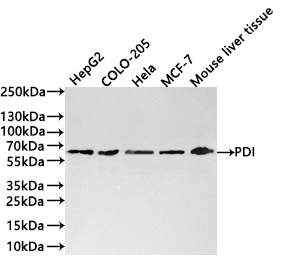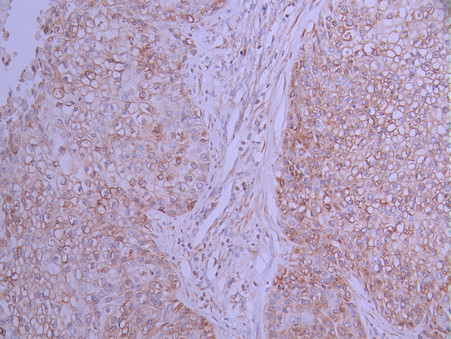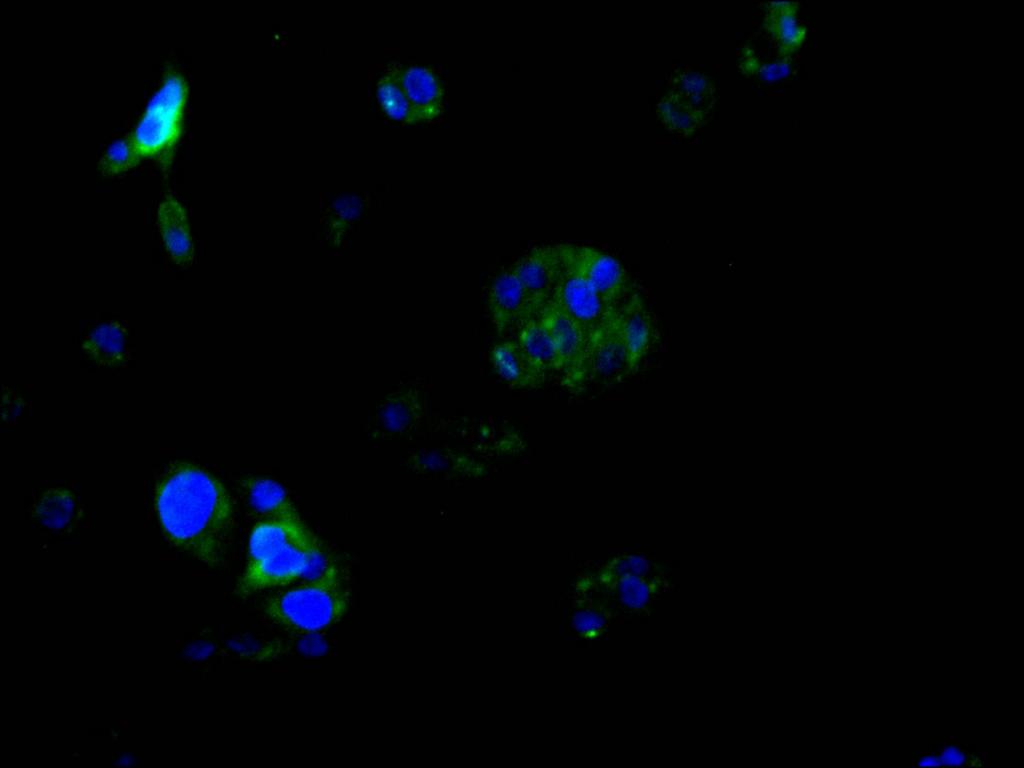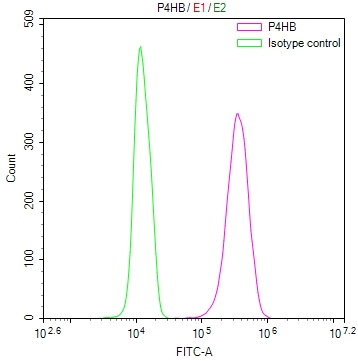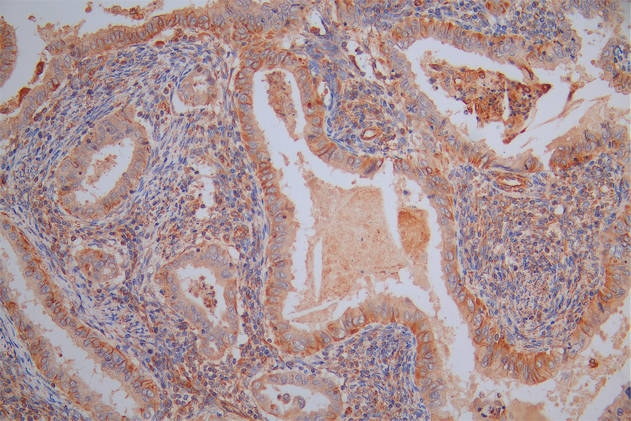P4HB Recombinant Monoclonal Antibody
-
中文名稱:P4HB Recombinant Monoclonal Antibody
-
貨號:CSB-RA923900A0HU
-
規(guī)格:¥1320
-
圖片:
-
Western Blot
Positive WB detected in: HepG2 whole cell lysate(30μg), COLO-205 whole cell lysate(30μg), Hela whole cell lysate(30μg), MCF-7 whole cell lysate(30μg), Mouse liver tissue lysate(30μg)
All lanes: PDI antibody at 1:1000
Secondary
Goat polyclonal to rabbit IgG at 1/40000 dilution
Predicted band size: 57 kDa
Observed band size: 60 kDa
Exposure time:3min -
IHC image of CSB-RA923900A0HU diluted at 1:100 and staining in paraffin-embedded human pancreatic cancer performed on a Leica BondTM system. After dewaxing and hydration, antigen retrieval was mediated by high pressure in a citrate buffer (pH 6.0). Section was blocked with 10% normal goat serum 30min at RT. Then primary antibody (1% BSA) was incubated at 4°C overnight. The primary is detected by a Goat anti-rabbit polymer IgG labeled by HRP and visualized using 0.05% DAB.
-
Immunofluorescence staining of HepG2 cell with CSB-RA923900A0HU at 1:50, counter-stained with DAPI. The cells were fixed in 4% formaldehyde and blocked in 10% normal Goat Serum. The cells were then incubated with the antibody overnight at 4°C. The secondary antibody was Alexa Fluor 488-congugated AffiniPure Goat Anti-Rabbit IgG(H+L).
-
Overlay Peak curve showing Hela cells stained with CSB-RA923900A0HU (red line) at 1:100. The cells were fixed in 4% formaldehyde and permeated by 0.2% TritonX-100 for?10min. Then 10% normal goat serum to block non-specific protein-protein interactions followed by the antibody (1ug/1*106cells) for 45min at 4℃. The secondary antibody used was FITC-conjugated goat anti-rabbit IgG (H+L) at 1/200 dilution for 35min at 4℃.Control antibody (green line) was Rabbit IgG (1ug/1*106cells) used under the same conditions. Acquisition of >10,000 events was performed.
-
-
其他:
產(chǎn)品詳情
-
Uniprot No.:
-
基因名:
-
別名:Protein disulfide-isomerase (PDI) (EC 5.3.4.1) (Cellular thyroid hormone-binding protein) (Prolyl 4-hydroxylase subunit beta) (p55), P4HB, ERBA2L PDI PDIA1 PO4DB
-
反應(yīng)種屬:Human, Mouse
-
免疫原:A synthesized peptide from human P4HB protein
-
免疫原種屬:Homo sapiens (Human)
-
標(biāo)記方式:Non-conjugated
-
克隆類型:Monoclonal
-
抗體亞型:Rabbit IgG
-
純化方式:Affinity-chromatography
-
克隆號:3F11
-
濃度:It differs from different batches. Please contact us to confirm it.
-
保存緩沖液:Preservative: 0.03% Proclin 300
Constituents: 50% Glycerol, 0.01M PBS, PH 7.4 -
產(chǎn)品提供形式:Liquid
-
應(yīng)用范圍:ELISA, WB, IHC, IF, FC
-
推薦稀釋比:
Application Recommended Dilution WB 1:500-1:2000 IHC 1:50-1:200 IF 1:50-1:200 FC 1:50-1:200 -
Protocols:
-
儲存條件:Upon receipt, store at -20°C or -80°C. Avoid repeated freeze.
-
貨期:Basically, we can dispatch the products out in 1-3 working days after receiving your orders. Delivery time maybe differs from different purchasing way or location, please kindly consult your local distributors for specific delivery time.
-
用途:For Research Use Only. Not for use in diagnostic or therapeutic procedures.
相關(guān)產(chǎn)品
靶點詳情
-
功能:This multifunctional protein catalyzes the formation, breakage and rearrangement of disulfide bonds. At the cell surface, seems to act as a reductase that cleaves disulfide bonds of proteins attached to the cell. May therefore cause structural modifications of exofacial proteins. Inside the cell, seems to form/rearrange disulfide bonds of nascent proteins. At high concentrations, functions as a chaperone that inhibits aggregation of misfolded proteins. At low concentrations, facilitates aggregation (anti-chaperone activity). May be involved with other chaperones in the structural modification of the TG precursor in hormone biogenesis. Also acts a structural subunit of various enzymes such as prolyl 4-hydroxylase and microsomal triacylglycerol transfer protein MTTP. Receptor for LGALS9; the interaction retains P4HB at the cell surface of Th2 T helper cells, increasing disulfide reductase activity at the plasma membrane, altering the plasma membrane redox state and enhancing cell migration.
-
基因功能參考文獻:
- Peroxynitrite preferentially oxidizes the dithiol redox motifs of protein-disulfide isomerase. PMID: 29191937
- Overexpression of HIF-1alpha and P4HB is associated with poor prognosis in patients with gastric cancer. PMID: 29904245
- Study demonstrated that the expression of P4HB is frequently upregulated at the mRNA and protein levels in diffuse gliomas. Its high expression was significantly correlated with high Ki-67, more TP53 mutations and poor survival outcome. These findings imply that high expression of P4HB plays an important role in diffuse glioma progression. PMID: 29207176
- identify a potent and selective PDIA1 inhibitor, KSC-34, with 30-fold selectivity for the a site over the a' site. KSC-34 displays time-dependent inhibition of PDIA1 reductase activity in vitro with a kinact/ KI of 9.66 x 10(3) M(-1) s(-1) and is selective for PDIA1 over other members of the PDI family, and other cellular cysteine-containing proteins. PMID: 29521097
- P4HB promotes hepatocellular carcinoma progression by down-regulating GRP78 expression and subsequently promoting epithelial-to-mesenchymal transition. PMID: 28052026
- analysis of antiplatelet activity of CxxC through binding to Cys400 in the PDI a0 domain, which can be further exploited as a model for sitedriven antithrombotic agent development PMID: 28109047
- Current findings indicate that thiol isomerase-mediated disulfide bond modification in receptors and plasma proteins is an important layer of control of thrombosis and vascular function more generally. PMID: 28598864
- DIA1 was robustly secreted by physiological levels of arterial laminar shear in endothelial cells and supported alpha 5 integrin thiol oxidation. PMID: 28034831
- Kinetic-based trapping by intervening sequence variants of the active sites of protein-disulfide isomerase identifies platelet protein substrates. PMID: 28364042
- a mechanism of dual Ero1alpha regulation by dynamic redox interactions between PDI and the two Ero1alpha flexible loops that harbor the regulatory cysteines. PMID: 27703014
- analysis of how redox affects human protein disulfide isomerase regulate binding affinity of 17 beta-estradiol PMID: 28257787
- These findings improve our understanding of PDI-protected aggregation of wild-type alpha-Syn and its H50Q familial mutant. PMID: 27142583
- Association of P4HB polymorphisms with sporadic amyotrophic lateral sclerosis susceptibility in the Chinese Han population. PMID: 26000911
- the effect of the endoplasmic reticulum chaperone protein disulfide isomerase (PDI) on beta-cell dysfunction, was examined. PMID: 26607804
- Amyotrophic lateral sclerosis-linked PDIA1 mutations disrupt motor neuron connectivity. PMID: 26869642
- direct binding of PDIA1 to VWF, is reported. PMID: 26670633
- Selective sequestration of PDI1A in a calcium depletion-mediated complex with the abundant chaperone calreticulin attenuates the effective concentration of this major lumenal thiol oxidant. PMID: 25575667
- Cole-Carpenter syndrome is caused by a specific de novo mutation in P4HB that impairs the disulfide isomerase activity of protein disulfide isomerase. PMID: 25683117
- PDI has a role as a competent regulator and a specific substrate of Ero1alpha govern efficient and faithful oxidative protein folding and maintain the ER redox homeostasis PMID: 25258311
- The crystal structure of the dimeric form of noncatalytic bb' domains of human PDIA1 determined to 2.3 A resolution revealed that the formation of dimers occludes the substrate binding site. PMID: 24549644
- Elevated P4HB expression is associated with temozolomide resistance in malignant glioma. PMID: 23444257
- ). The results suggest that P4HB is a modifier gene inamyotrophic lateral sclerosis susceptibility and may represent a potential therapeutic target for amyotrophic lateral sclerosis . PMID: 23337974
- A mixed disulfide complex was formed with the catalytic domain A1 from human PDI consistent with a model for cotranslational oxidative protein folding wherein PDI acts as a placeholder that is relieved by the pairing of cysteines caused by substrate folding. PMID: 23141538
- TPM4, PDIA and SRC8 were also localized to the trophoblast cells, further highlighting the importance of these cytoskeletal remodelling proteins in early pregnancy PMID: 21373848
- these data revealed a redox-regulated chaperone function of PDI in delivering antigenic peptides from TAP to MHC-I. PMID: 21299467
- Functional PDI is rapidly secreted from human umbilical vein endothelial cells in culture upon activation with thrombin or after laser-induced stimulation. PMID: 20668226
- domain c is required for the stabilization and maintenance of the chaperone function of PDI under extreme conditions PMID: 15358778
- data indicate that binding sites in three PDI domains, a, b', and a', contribute to efficient C-P4H tetramer assembly PMID: 15590633
- PDI can be S-nitrosated and PDI-SNO can be denitrosated by PDI suggesting that this enzyme could be intimately involved in the transport of intracellular NO equivalents to the cell surface. PMID: 15611098
- Data show that protein disulfide isomerase can switch its conformation from dimer to tetramer in its functions as a foldase. PMID: 15695804
顯示更多
收起更多
-
相關(guān)疾病:Cole-Carpenter syndrome 1 (CLCRP1)
-
亞細胞定位:Endoplasmic reticulum. Endoplasmic reticulum lumen. Melanosome. Cell membrane; Peripheral membrane protein.
-
蛋白家族:Protein disulfide isomerase family
-
數(shù)據(jù)庫鏈接:
Most popular with customers
-
-
YWHAB Recombinant Monoclonal Antibody
Applications: ELISA, WB, IHC, IF, FC
Species Reactivity: Human, Mouse, Rat
-
Phospho-YAP1 (S127) Recombinant Monoclonal Antibody
Applications: ELISA, WB, IHC
Species Reactivity: Human
-
-
-
-
-

